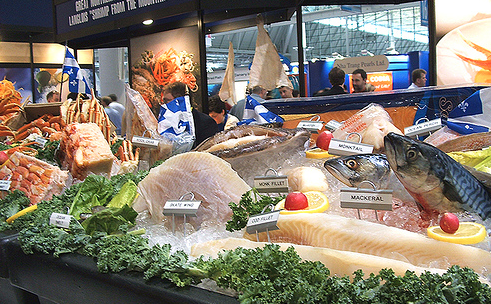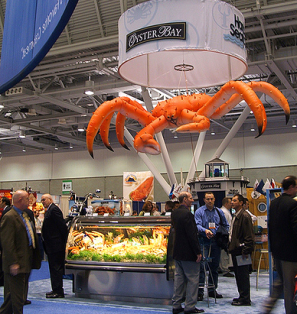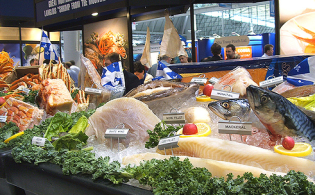More than 18,000 people from 120 countries are attending this year’s International Boston Seafood Show, which wraps up today on the city’s waterfront. Every year, the glass-enclosed, aquarium-like convention center becomes a spectacle of sushi, salmon, scrod, and the people who import, export, wholesale, retail, filet, package, refrigerate, and ship them.
In the past, there was little mention of sustainability amid all the buying and selling, says Katie Semon, of the National Oceanic and Atmospheric Association’s (NOAA) fisheries service. I found her manning a booth at the outer edge of 1,700 displays laid out in a rectangular grid the size of several city blocks. “It’s everything now,” she says.
And she has a point. You hear the term “sustainable” a lot as food-service reps stroll and sample crab cakes, roe, and marinated squid. But even as 70 percent of the world’s marine fisheries are depleted or fully exploited, global implementation of science-based management remains uneven. And hard to track.
It’s no wonder consumers are confused. There are more than 30 different types of certifications for seafood in U.S. supermarket display cases. The labels are supposed to be the seal of approval for mercury testing, catch method, fisheries management, water quality, and other aspects of the path from ocean to plate. “Seafood is by far the most complicated product,” Jeanne von Zastrow, senior director of sustainability and industry relations for the Food Marketing Institute, told a side gathering of supermarket officials Sunday.
To help consumers make smart seafood choices, NOAA launched its revamped FishWatch site at the Boston show this week. NOAA’s websites have long been a technical resource for the seafood industry on U.S. fish populations and catch limits. Now, it’s clear that NOAA is trying to reach a wider audience; those science-based facts have been repackaged for diners and shoppers in a user-friendly format with quick links for background on abundance, habitat impacts, and bycatch associated with a particular species.
Commercial fishing in U.S. waters is the most thoroughly regulated in the world, something I keep in mind when I’m at the fish counter. Gulf of Maine and Georges Bank haddock, for example, were dangerously overfished in the early 1990s. But under quotas set by NOAA and the New England Fishery Management Council, haddock has made a strong and stable comeback.
Still, 86 percent of seafood we eat here is imported. FishWatch doesn’t yet help sort through foreign fish, but NOAA plans to add information on imports as well as profiles of farm-raised fish (which accounts for almost half the seafood we now eat), Semon says.
I often turn to the Monterey Bay Aquarium’s Seafood Watch for fish-by-fish advice; the guide offers insight on imports and aquaculture as well as the impact of catch techniques such as line, gillnet, or trawler. No single label or website has all the answers, but retailers are getting the message that consumers will choose sustainable fish when they know which fish that is.
After a few hours navigating the Boston show on Sunday, I was getting hungry. Having grown up in Buffalo, N.Y., on Lake Erie, I know from personal experience one fish that is so plentiful it’s like a weed. It is also well-regulated, netted without damage to the lake floor or significant bycatch, and it’s delicious. I left the NOAA booth and walked past Praxair refrigeration, past guys in matching Red Lobster shirts, past Donggang Jufheg Food Co. Ltd., and past a foggy-eyed sturgeon on ice. I eventually found a vendor from Wheatley, Ontario, the lone exhibitor from the Great Lakes. There I stood and ate with a wooden toothpick and a clear conscience several bites of fried yellow perch.





